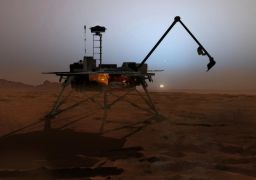Emily Lakdawalla • Oct 28, 2008
The beginning of the end for Phoenix: No more robotic arm operations
NASA and JPL issued a statement today that marks the beginning of Phoenix' descent into death. But by taking the steps outlined in today's statement, the mission hopes to put off that death as long as possible.
With less and less sunlight each sol, and more frequent cloudy days, Phoenix' solar cells are generating less power each day. At the same time, it's getting colder, so the spacecraft is requiring more and more power just to keep its instruments and systems warm. Soon there will not be enough power generated each day to power the heaters and still manage to do any operations.
So the team is going to have to start powering down those survival heaters, and accept the resultant loss of function. Here are the steps described in today's statement:
- Today (sol 152), the robotic arm made its last move. It is now parked with the Thermal and Electrical Conductivity Probe (TECP) inserted in soil in front of the lander.
- Later today, the spacecraft will be instructed to turn off the first of five survival heaters. This heater warms the robotic arm, robotic arm camera, and Thermal and Evolved Gas Analyzer (TEGA) instrument. This step alone will conserve 250 watt-hours of power a day (which, I'll note, is more than Spirit survived on during the coldest parts of its winter -- but then, Spirit sits near the equator, a much warmer spot on Mars). So, there will be no more soil or ice samples gathered. The statement didn't indicate whether this also means that TEGA is done with its analyses -- I'll try to get an answer to that. The TECP needs no heater and "should continue to send back data for weeks," according to the statement.
- When that savings isn't enough a second heater that serves the pyrotechnic initiation unit will be disabled. This unit has not been used since landing. There must be a good reason why this heater hasn't been turned off yet, but the statement didn't specify; I'll ask.
- The next heater to be shut down will be the one that serves the mast-mounted camera and the meteorological suite. According to the statement, these instruments generate enough heat just by functioning that most of their components should continue to work without the heater.
- Finally, one of the two heaters that warms the spacecraft's electronic guts and batteries will be powered down.
- The final heater will be left to "run out on its own," keeping Phoenix alive as long as it can hang on against the rigors of the oncoming polar winter.
Let’s Go Beyond The Horizon
Every success in space exploration is the result of the community of space enthusiasts, like you, who believe it is important. You can help usher in the next great era of space exploration with your gift today.
Donate Today

 Explore Worlds
Explore Worlds Find Life
Find Life Defend Earth
Defend Earth


